Ruihan Zhao
Learning Human Perception Dynamics for Informative Robot Communication
Feb 03, 2025



Abstract:Human-robot cooperative navigation is challenging in environments with incomplete information. We introduce CoNav-Maze, a simulated robotics environment where a robot navigates using local perception while a human operator provides guidance based on an inaccurate map. The robot can share its camera views to improve the operator's understanding of the environment. To enable efficient human-robot cooperation, we propose Information Gain Monte Carlo Tree Search (IG-MCTS), an online planning algorithm that balances autonomous movement and informative communication. Central to IG-MCTS is a neural human perception dynamics model that estimates how humans distill information from robot communications. We collect a dataset through a crowdsourced mapping task in CoNav-Maze and train this model using a fully convolutional architecture with data augmentation. User studies show that IG-MCTS outperforms teleoperation and instruction-following baselines, achieving comparable task performance with significantly less communication and lower human cognitive load, as evidenced by eye-tracking metrics.
Dense Dynamics-Aware Reward Synthesis: Integrating Prior Experience with Demonstrations
Dec 02, 2024



Abstract:Many continuous control problems can be formulated as sparse-reward reinforcement learning (RL) tasks. In principle, online RL methods can automatically explore the state space to solve each new task. However, discovering sequences of actions that lead to a non-zero reward becomes exponentially more difficult as the task horizon increases. Manually shaping rewards can accelerate learning for a fixed task, but it is an arduous process that must be repeated for each new environment. We introduce a systematic reward-shaping framework that distills the information contained in 1) a task-agnostic prior data set and 2) a small number of task-specific expert demonstrations, and then uses these priors to synthesize dense dynamics-aware rewards for the given task. This supervision substantially accelerates learning in our experiments, and we provide analysis demonstrating how the approach can effectively guide online learning agents to faraway goals.
Human-Agent Coordination in Games under Incomplete Information via Multi-Step Intent
Oct 23, 2024Abstract:Strategic coordination between autonomous agents and human partners under incomplete information can be modeled as turn-based cooperative games. We extend a turn-based game under incomplete information, the shared-control game, to allow players to take multiple actions per turn rather than a single action. The extension enables the use of multi-step intent, which we hypothesize will improve performance in long-horizon tasks. To synthesize cooperative policies for the agent in this extended game, we propose an approach featuring a memory module for a running probabilistic belief of the environment dynamics and an online planning algorithm called IntentMCTS. This algorithm strategically selects the next action by leveraging any communicated multi-step intent via reward augmentation while considering the current belief. Agent-to-agent simulations in the Gnomes at Night testbed demonstrate that IntentMCTS requires fewer steps and control switches than baseline methods. A human-agent user study corroborates these findings, showing an 18.52% higher success rate compared to the heuristic baseline and a 5.56% improvement over the single-step prior work. Participants also report lower cognitive load, frustration, and higher satisfaction with the IntentMCTS agent partner.
PEERNet: An End-to-End Profiling Tool for Real-Time Networked Robotic Systems
Sep 09, 2024Abstract:Networked robotic systems balance compute, power, and latency constraints in applications such as self-driving vehicles, drone swarms, and teleoperated surgery. A core problem in this domain is deciding when to offload a computationally expensive task to the cloud, a remote server, at the cost of communication latency. Task offloading algorithms often rely on precise knowledge of system-specific performance metrics, such as sensor data rates, network bandwidth, and machine learning model latency. While these metrics can be modeled during system design, uncertainties in connection quality, server load, and hardware conditions introduce real-time performance variations, hindering overall performance. We introduce PEERNet, an end-to-end and real-time profiling tool for cloud robotics. PEERNet enables performance monitoring on heterogeneous hardware through targeted yet adaptive profiling of system components such as sensors, networks, deep-learning pipelines, and devices. We showcase PEERNet's capabilities through networked robotics tasks, such as image-based teleoperation of a Franka Emika Panda arm and querying vision language models using an Nvidia Jetson Orin. PEERNet reveals non-intuitive behavior in robotic systems, such as asymmetric network transmission and bimodal language model output. Our evaluation underscores the effectiveness and importance of benchmarking in networked robotics, demonstrating PEERNet's adaptability. Our code is open-source and available at github.com/UTAustin-SwarmLab/PEERNet.
Reduce, Reuse, Recycle: Categories for Compositional Reinforcement Learning
Aug 23, 2024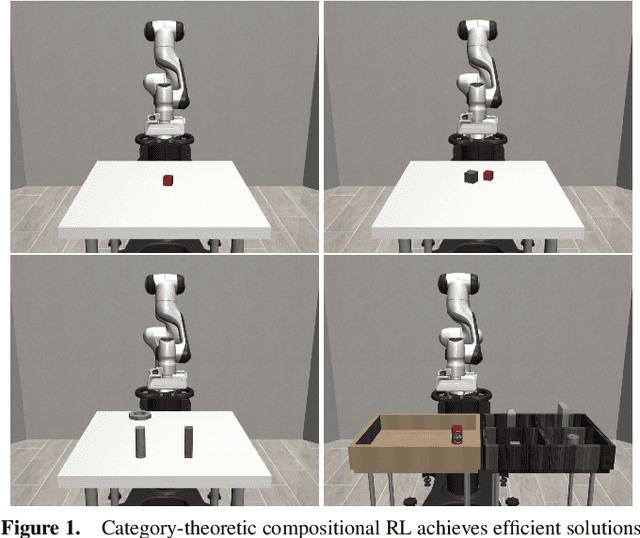
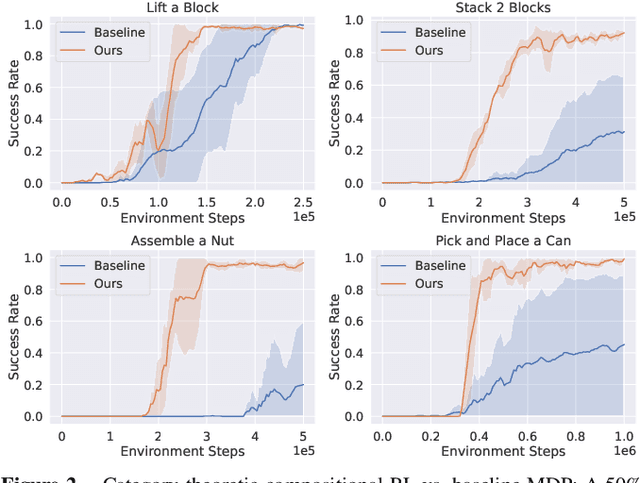
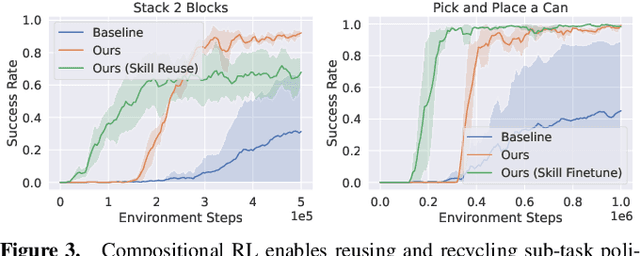
Abstract:In reinforcement learning, conducting task composition by forming cohesive, executable sequences from multiple tasks remains challenging. However, the ability to (de)compose tasks is a linchpin in developing robotic systems capable of learning complex behaviors. Yet, compositional reinforcement learning is beset with difficulties, including the high dimensionality of the problem space, scarcity of rewards, and absence of system robustness after task composition. To surmount these challenges, we view task composition through the prism of category theory -- a mathematical discipline exploring structures and their compositional relationships. The categorical properties of Markov decision processes untangle complex tasks into manageable sub-tasks, allowing for strategical reduction of dimensionality, facilitating more tractable reward structures, and bolstering system robustness. Experimental results support the categorical theory of reinforcement learning by enabling skill reduction, reuse, and recycling when learning complex robotic arm tasks.
An Efficient Reconstructed Differential Evolution Variant by Some of the Current State-of-the-art Strategies for Solving Single Objective Bound Constrained Problems
Apr 25, 2024Abstract:Complex single-objective bounded problems are often difficult to solve. In evolutionary computation methods, since the proposal of differential evolution algorithm in 1997, it has been widely studied and developed due to its simplicity and efficiency. These developments include various adaptive strategies, operator improvements, and the introduction of other search methods. After 2014, research based on LSHADE has also been widely studied by researchers. However, although recently proposed improvement strategies have shown superiority over their previous generation's first performance, adding all new strategies may not necessarily bring the strongest performance. Therefore, we recombine some effective advances based on advanced differential evolution variants in recent years and finally determine an effective combination scheme to further promote the performance of differential evolution. In this paper, we propose a strategy recombination and reconstruction differential evolution algorithm called reconstructed differential evolution (RDE) to solve single-objective bounded optimization problems. Based on the benchmark suite of the 2024 IEEE Congress on Evolutionary Computation (CEC2024), we tested RDE and several other advanced differential evolution variants. The experimental results show that RDE has superior performance in solving complex optimization problems.
Task-aware Distributed Source Coding under Dynamic Bandwidth
May 24, 2023Abstract:Efficient compression of correlated data is essential to minimize communication overload in multi-sensor networks. In such networks, each sensor independently compresses the data and transmits them to a central node due to limited communication bandwidth. A decoder at the central node decompresses and passes the data to a pre-trained machine learning-based task to generate the final output. Thus, it is important to compress the features that are relevant to the task. Additionally, the final performance depends heavily on the total available bandwidth. In practice, it is common to encounter varying availability in bandwidth, and higher bandwidth results in better performance of the task. We design a novel distributed compression framework composed of independent encoders and a joint decoder, which we call neural distributed principal component analysis (NDPCA). NDPCA flexibly compresses data from multiple sources to any available bandwidth with a single model, reducing computing and storage overhead. NDPCA achieves this by learning low-rank task representations and efficiently distributing bandwidth among sensors, thus providing a graceful trade-off between performance and bandwidth. Experiments show that NDPCA improves the success rate of multi-view robotic arm manipulation by 9% and the accuracy of object detection tasks on satellite imagery by 14% compared to an autoencoder with uniform bandwidth allocation.
Learning Sparse Control Tasks from Pixels by Latent Nearest-Neighbor-Guided Explorations
Feb 28, 2023Abstract:Recent progress in deep reinforcement learning (RL) and computer vision enables artificial agents to solve complex tasks, including locomotion, manipulation and video games from high-dimensional pixel observations. However, domain specific reward functions are often engineered to provide sufficient learning signals, requiring expert knowledge. While it is possible to train vision-based RL agents using only sparse rewards, additional challenges in exploration arise. We present a novel and efficient method to solve sparse-reward robot manipulation tasks from only image observations by utilizing a few demonstrations. First, we learn an embedded neural dynamics model from demonstration transitions and further fine-tune it with the replay buffer. Next, we reward the agents for staying close to the demonstrated trajectories using a distance metric defined in the embedding space. Finally, we use an off-policy, model-free vision RL algorithm to update the control policies. Our method achieves state-of-the-art sample efficiency in simulation and enables efficient training of a real Franka Emika Panda manipulator.
Class-Aware Generative Adversarial Transformers for Medical Image Segmentation
Jan 28, 2022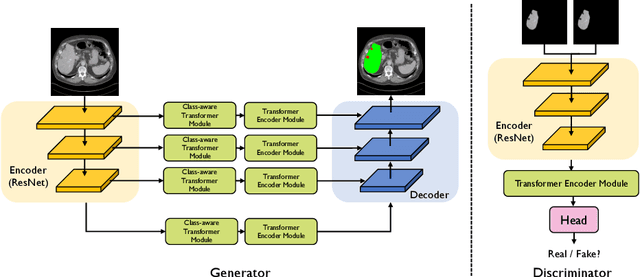

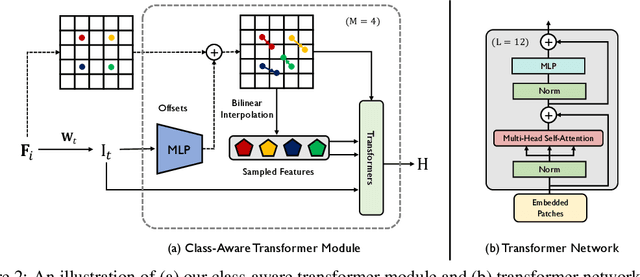
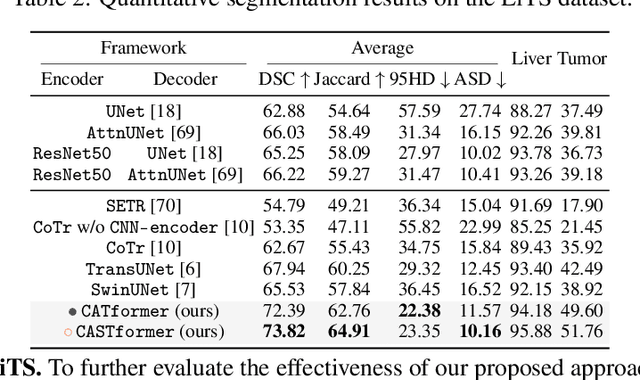
Abstract:Transformers have made remarkable progress towards modeling long-range dependencies within the medical image analysis domain. However, current transformer-based models suffer from several disadvantages: (1) existing methods fail to capture the important features of the images due to the naive tokenization scheme; (2) the models suffer from information loss because they only consider single-scale feature representations; and (3) the segmentation label maps generated by the models are not accurate enough without considering rich semantic contexts and anatomical textures. In this work, we present CA-GANformer, a novel type of generative adversarial transformers, for medical image segmentation. First, we take advantage of the pyramid structure to construct multi-scale representations and handle multi-scale variations. We then design a novel class-aware transformer module to better learn the discriminative regions of objects with semantic structures. Lastly, we utilize an adversarial training strategy that boosts segmentation accuracy and correspondingly allows a transformer-based discriminator to capture high-level semantically correlated contents and low-level anatomical features. Our experiments demonstrate that CA-GANformer dramatically outperforms previous state-of-the-art transformer-based approaches on three benchmarks, obtaining 2.54%-5.88% absolute improvements in Dice over previous models. Further qualitative experiments provide a more detailed picture of the model's inner workings, shed light on the challenges in improved transparency, and demonstrate that transfer learning can greatly improve performance and reduce the size of medical image datasets in training, making CA-GANformer a strong starting point for downstream medical image analysis tasks. Codes and models will be available to the public.
MEGAN: Memory Enhanced Graph Attention Network for Space-Time Video Super-Resolution
Oct 28, 2021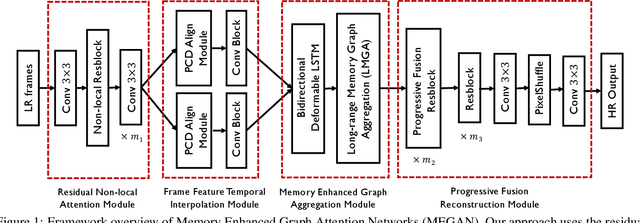
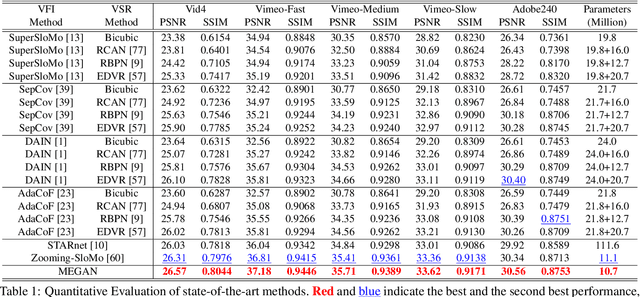

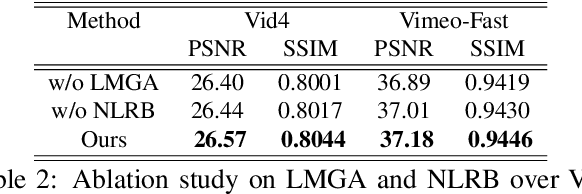
Abstract:Space-time video super-resolution (STVSR) aims to construct a high space-time resolution video sequence from the corresponding low-frame-rate, low-resolution video sequence. Inspired by the recent success to consider spatial-temporal information for space-time super-resolution, our main goal in this work is to take full considerations of spatial and temporal correlations within the video sequences of fast dynamic events. To this end, we propose a novel one-stage memory enhanced graph attention network (MEGAN) for space-time video super-resolution. Specifically, we build a novel long-range memory graph aggregation (LMGA) module to dynamically capture correlations along the channel dimensions of the feature maps and adaptively aggregate channel features to enhance the feature representations. We introduce a non-local residual block, which enables each channel-wise feature to attend global spatial hierarchical features. In addition, we adopt a progressive fusion module to further enhance the representation ability by extensively exploiting spatial-temporal correlations from multiple frames. Experiment results demonstrate that our method achieves better results compared with the state-of-the-art methods quantitatively and visually.
 Add to Chrome
Add to Chrome Add to Firefox
Add to Firefox Add to Edge
Add to Edge